In this lesson, you will learn how to play Four on Six, a standard written by Wes Montgomery. In 1960, Wes Montgomery’s album “The Incredible Jazz Guitar” was released with on it two of his most famous compositions, “West Coast Blues” and “Four on Six”. Four on Six is a great song to play and your audience will love it!
Btw, if you were wondering what the meaning of the song title “Four on Six” is, it refers to a 4/4 rhythm superimposed over a rhythm of 6/8.
Here’s a video of Wes Montgomery performing Four on Six:
Here’s how the complete them sounds like:
Here’s a backing track to practice your solos:
Four on Six – The Theme
The Intro
Four on Six has a great intro that is made entirely out of fifths and played in unison with the bass and piano.
Here’s is how the intro sounds like:
And here’s how you play it. I mute the strings a bit with the palm of my right hand:
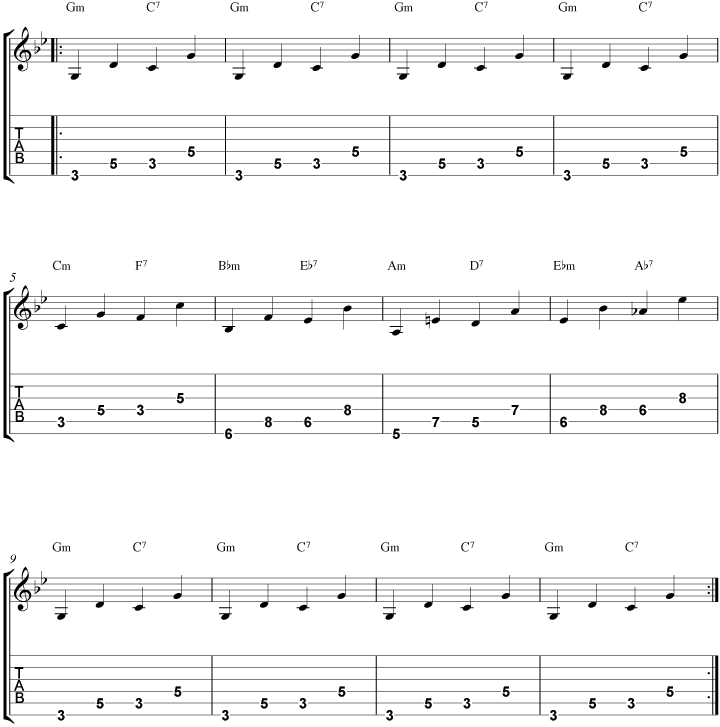
The Break
The intro is followed by a break that can be a bit challenging in the beginning:

The Melody
The melody is a modal line that moves around the notes of Gm9:

The Chord Accents
The melody is followed by a II V sequence with strong accents. The II Vs follow the harmony of the intro:
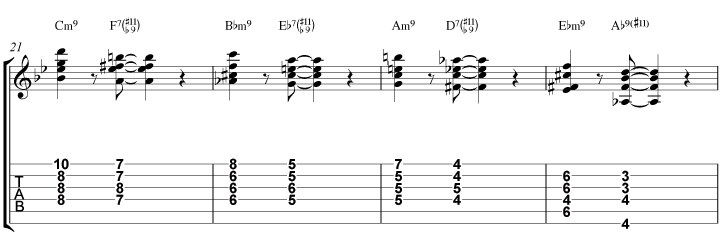
The accents are followed by the theme again, then the break before the solos start.
Four on Six – Improvisation
Here are the chord changes for the solos:
|Gm7 | | | |
|Cm7 F7 |Bbm7 Eb7 |Am7 D7 |Ebm7 Ab7 |
|Gm7 | | |Cm7 F7 |
|Bbmaj7 |Am7b5 D7 |Gm7 | D7 |
The chords are not very hard to improvise over, although the tempo makes it challenging (202 bpm).
Bars 1-4
Over the Gm7 chord, Wes Montgomery generally plays the G Dorian mode, blues scales, and arpeggios.
G Dorian
Here’s the scale diagram for G Dorian in root position:
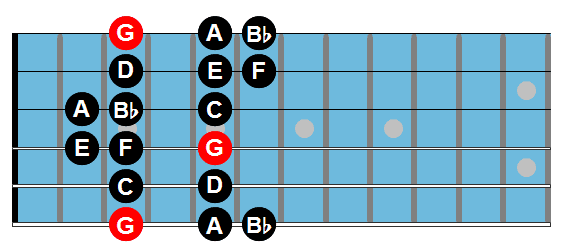
Don’t limit yourself to this position though, learn to play the scale over the entire neck, like this:
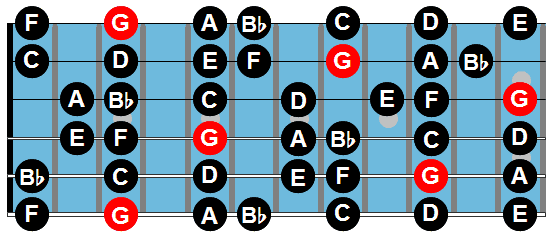
G Minor Pentatonic and G Minor Blues Scale
Another guitar scale Wes uses over Gm7 is the minor pentatonic scale or the minor blues scale.
Here are the 2 main positions of this scale, but the same applies as above, learn the scale over the entire neck.
The blue notes are shown in orange, use them to slide, hammer or pull into the notes D or C.
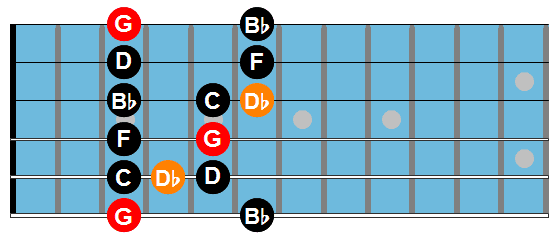
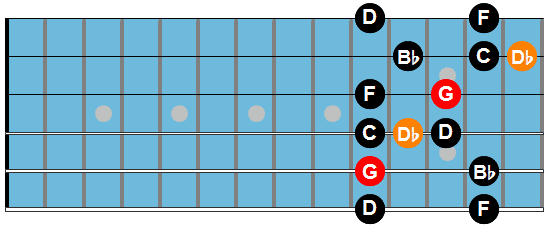
Here Wes Montgomery uses a unison-interval blues cliche.

Gm7 Arpeggio
Wes also uses arpeggios over the Gm7, most of the times a Gm9 arpeggio.
He often makes big jumps on the fretboard, like in this example:

Sometimes the G minor goes to C7, like in the following example:

Gm/maj7 Arpeggio
Wes also uses m/maj7 arpeggios. A minor/major7 chord is a minor chord with a natural 7.
In this example Wes plays a Gm/maj7 arpeggio first, followed by a Gm7 arpeggio resolving into the 3rd of C7:

Bars 5-8
These are a series of 4 II-Vs.
On the theme, the dominant chords have a natural 9 and a sharp 11 (F9#11).
The scale played on chords with these tensions is the melodic minor scale.
Cm7 F7
Play the C melodic minor scale here.
On the F7 the name of this scale is the Lydian dominant scale (4th mode of the melodic minor scale).
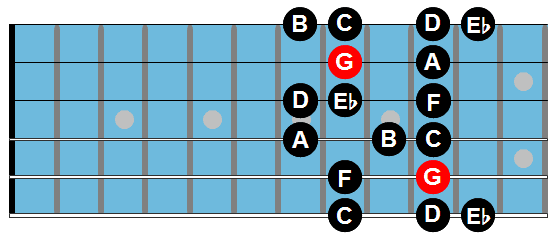
Bbm7 Eb7
Here you play Bb melodic minor, the same scale as in the above scale diagram, but 2 frets lower.
Am7 D7
A melodic minor
Ebm7 Ab7
Eb melodic minor
Wes Montgomery doesn’t think in scales on this part, but in melodic patterns.
That’s a good idea because the tempo is so fast, which makes it difficult to play scales musically. He usually plays a pattern on the first II V and transposes it down the neck for the rest of the II Vs.
Here’s an example where he uses a minor 9-11 pattern.

Here’s another example, this time Wes Montgomery uses his famous octaves.
Wes “strums” the octaves with his thumb, but you can also play them with thumb and index finger.

Bars 9-12
The same modal part as bars 1 to 4, the only difference is a II V to Bbmaj7 in the last bar.
Bars 13-16
In this example, Wes plays the D altered scale over bar 14:
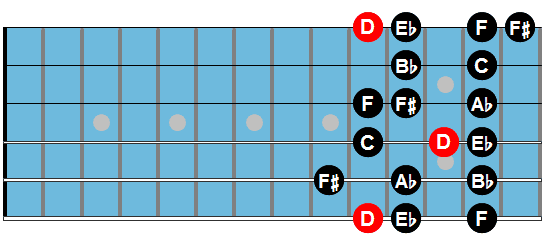

Learn how to play in the style of Wes Montgomery step-by-step with our in-depth course How to Play in the Style of Wes Montgomery



Awesome lesson! Thank you.
I’ve been studying this song slowed down on Transcribe!
I’ve had a lot of trouble phrasing the Bbma7 Gm Abmin11 Amin11 D7#9 , mainly that quick move from the Ab Am 11s. You have it as a slide. I think that Wes played the Abm11 as an up stroke. With it slowed right down it does sound as the high notes of the chord sound first. With the other chords played as down strokes, the up stroke sounds right for the phrasing. What do you think? Great lesson and thanks.
Wonderful lesson! Thank you
Nice info, Matt. I don’t think I saw this when “Four On Six” was the tune of the month in PJG group. Thanks. I will try and come back to this as time permits (time does seem to be in control, doling out minutes and seconds as to a patient etherized upon a table)
In the second measure of the melody the triplet is a D Eb C, not D Eb D. FYI
I think you’re looking at the real book, which isn’t correct here. Check the recording, it’s D-Eb-D. Maybe the real book used a different recording or something or just a typo.
Excellent material. Thank you Dirk Laukens.
I need help understanding from a theory/compositional stand point how the Ebm7 is arrived at in the 2nd line:
|Cm7 F7 |Bbm7 Eb7 |Am7 D7 |Ebm7 Ab7 |
Although these are all ii-Vs, there’s an underlying ‘hidden root’ these are based upon (at least in my way of thinking – perhaps incorrectly?).
For example – the Cm7 is focusing on the Cm as the V to the key of the song in Gm and the F7 simply is the V in the ii-V relationship to the Cm7. The Bbm7 is the ii relating back to the Cm as I in the previous bar (and subsequently the Eb7 is the V in the ii-V of Bbm7 when the Bbm7 is acting as the ii).
The Am7 takes a new turn as the Am7 relates as the ii back to the Gm7 (as the I), and of course the D7 is just the V in the ii-V of Am7.
But the Ebm7?
How is that related to the Gm7? or the previous Am7? It’s a bV of Gm, it’s not a tritone substitution either. What theoretical substitution rule or jazz tidbit am I missing on how that Ebm7 came to be in Wes’ head?
Hi TJ
Ab7 is the tritone substitution of D7 (the V of Gm7). Ebm7 is the ii of that tritone substituted Ab7.
I hope that explains it, let me know if you have more questions.
Dirk
Immensely!
I realize now after reading your comment that the answer is in the very last measure of the 16 measures – as it ends with D7 – and your comment pulled it all together.
Also stoked I got a reply within hours of posting!
thanks!
Thanks you for the lesson. One of Wes greatest tunes. I’ll be shedding this one for a while.
Long time guitar player, but first lesson, first day of jazz guitar.
This looks great. Thanks
Thank you for your engagement and lessons of jazz
Paul
I taught the lydian dom scale is the 4th mode of the melodic minor scale and not the 5th as indicated.
You’re totally correct Pol, I fixed the typo…
Worth remembering it’s really just a version of Summertime.
Yes,with a few twists. But you are correct, when you listen to the Wes version of Summertime it’s exactly the same even down to the bass line!
Very nice course
Much appreciated! Great song and likely one of the best songs Wes ever wrote imho. This song shows his depth and monstrosity along with his knowledge and expertise combining chords, melody along with time and space! The beat alone brings many listeners onboard, even non-jazzers!! Thanks again!! I love this song!!